Brisbane and Gold Coast are Australia’s favorite resort cities. Here, there is almost a guarantee of good weather, bathing and all the entertainment you can imagine, for which not least the Gold Coast is so famous.
However, Brisbane has much more than the beaches to offer. There are several art museums, and if you want to go back to the early development of the area, there are preserved buildings from the 19th century. If you suddenly want to go to the beach, it can also be fulfilled in the very center of the city where the inviting South Bank Parklands are located.
Australia’s magnificent scenery is never far from anywhere in the big country, nor from Brisbane. From here many will probably choose a boat trip on Moreton Bay, where the area’s first penal colony was located.
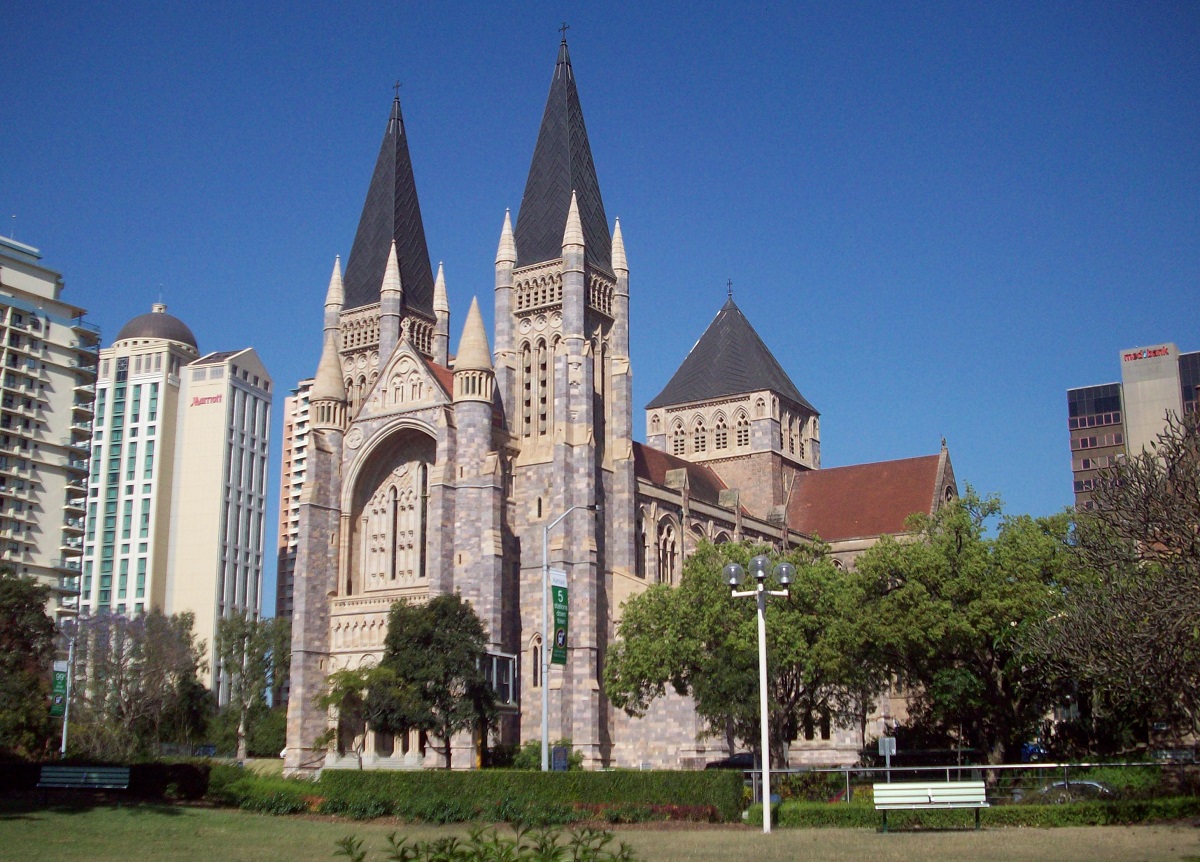
St John’s Cathedral is Brisbane’s Anglican cathedral, and it stands as the city’s most impressive church building. The cathedral is dedicated to St. John the Baptist and is located on Ann Street in Brisbane’s central business district. Here, the old church lies side by side with modern high-rise buildings, thereby forming an exciting historical contrast.
The cathedral was conceived already in the 1880s by William Webber, who was Brisbane’s bishop at the time. Webber commissioned the architect John Loughborough Pearson to draw up a proposal for a new cathedral, and the plan was approved in 1889. However, it took until 1901 before the later King George V could lay the foundation stone for the cathedral.
The great St John’s Cathedral was then built in several stages. The first part of the church was built from 1906 and consecrated in 1910. The next phase of construction started in 1965, while the third and final phase was started in 1989. After that, the impressive cathedral was consecrated in 2009. Thus it took over a hundred years to build the neo-Gothic cathedral.
The cathedral stands with impressive architecture. John Loughborough Pearson was also one of the leading English church architects of his time, and he built, among other things, Truro Cathedral, which may have been an inspiration for the cathedral in Brisbane. The exterior is characterized by the striking towers, while the interior is like entering a church from centuries ago with clean Gothic lines.
Customs House is Brisbane’s old customs house and is one of the finest examples of colonial architecture in the city. The style is neoclassicism, and with a large dome, the house is one of the area’s distinctive old buildings. The house was built 1886-1889 to designs by Charles McLay of the Queensland Colonial Architect’s Office.
The Customs House was an important institution, as imported goods were cleared here. It provided important income for the city, where industrial production developed only slowly compared to other places. The customs authorities had their seat in the house until the 1980s, when the Australian Customs Department moved to another address.
Since then, the Customs House has been renovated, and the house has been used by the city’s university, among others. Customs House also forms the setting for concerts and other events in the house’s hall, which was prepared for cultural events with the renovation.
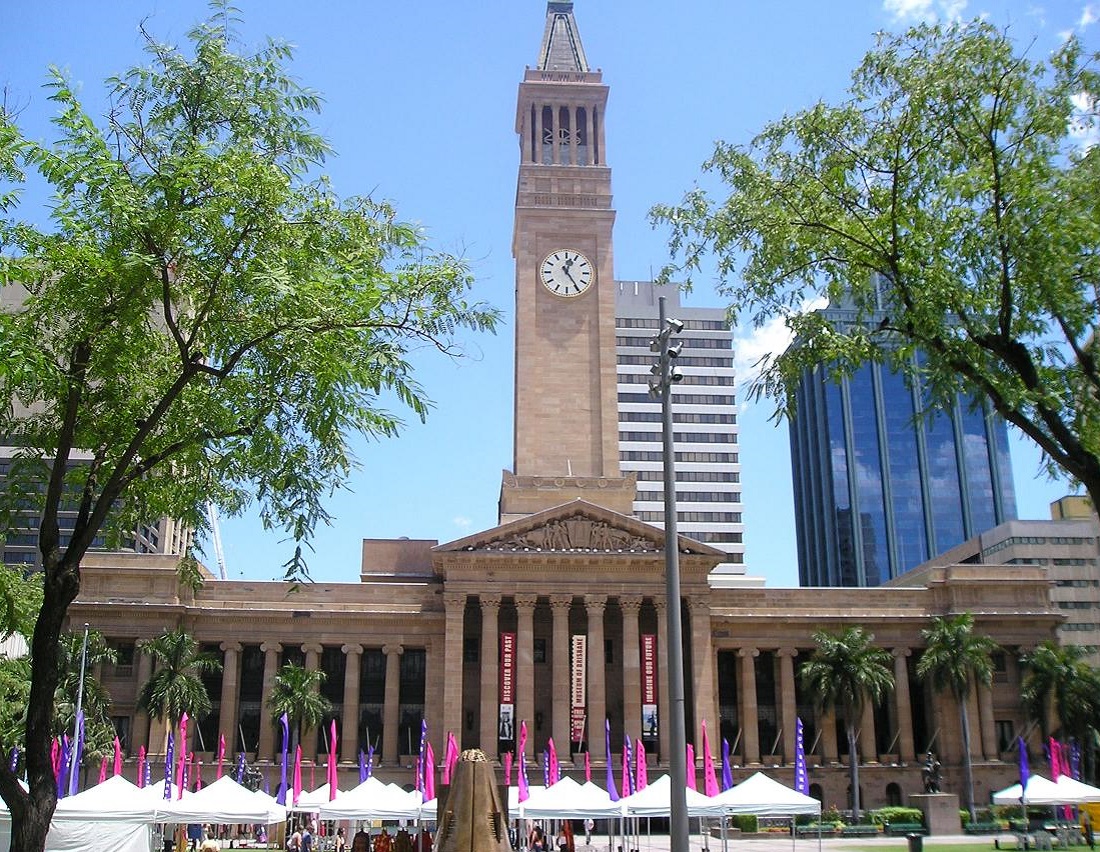
City Hall is Brisbane’s town hall, which was built in the period 1920-1930. When it opened, the town hall was the city’s tallest building. Before construction, there had been plans for the building for many years, before the city’s mayor in 1914 decided on the location on the current King George Square.
In 1917, a foundation stone was laid, but it had to be moved again, as it was not located correctly in relation to the future buildings. Therefore, a new foundation stone was laid in 1920, and it was laid by the later British King Edward VIII. The town hall was partially occupied in 1927, but it was formally opened in 1930.
City Hall was built with inspiration from Italian Renaissance and Greek architecture with both Ionic and Corinthian columns on the facade. The central and 64 meter high bell tower was designed with inspiration from the Campanile in St. Mark’s Square in Venice, and it was opened with Australia’s largest clock faces.
Inside are a number of fine decorations of the town hall’s halls, where the largest and most central is the building’s auditorium. The auditorium was built with the Pantheon in Rome as a model, and 1,600 people can sit in the circular space. The Council Chamber is another of the best-known rooms in the town hall, just as the foyer with its large marble staircase is also worth seeing.
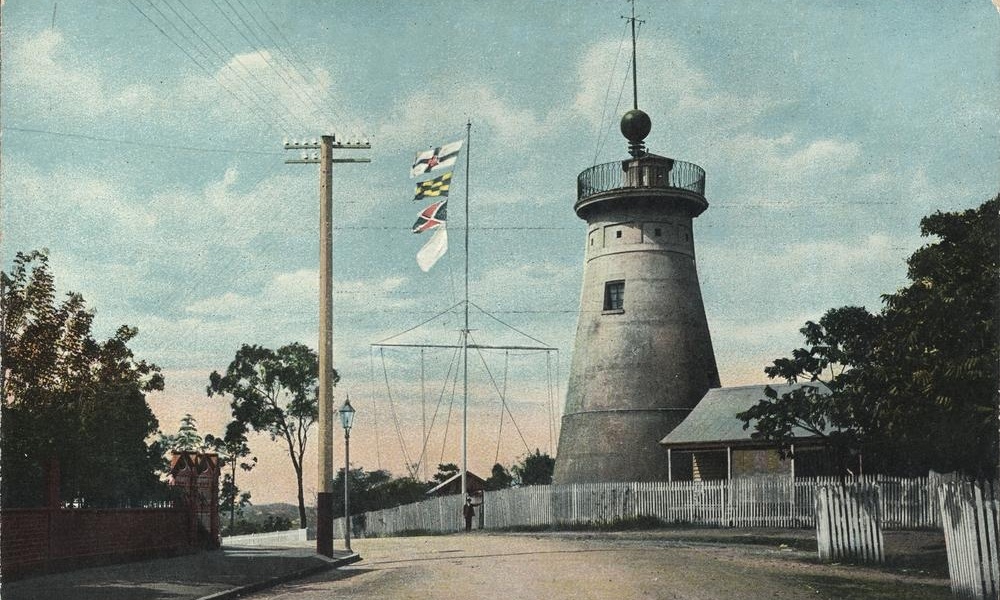
The Old Windmill is a windmill in Brisbane, which was built by convicts in 1828. The windmill therefore stands as Brisbane’s oldest preserved building. When the mill was built, it stood well above the terrain. The building was used as a mill until 1861, when it was converted into an observatory and signal station, and the Queensland Museum was temporarily located here as well.
The mill was built to grind and process the wheat and maize crops of the Moreton Bay settlement and had a treadmill for times when there was no wind. This part could also be used as a tool to punish convicts who worked here. The mill was in operation grinding grain until 1845.
After the mill’s closure, The Old Windmill was sold for demolition, but it did not happen. Over the years, the 16 meter high mill tower became a popular destination for visitors, and in recent decades the building has been refurbished. Today there is access to The Old Windmill, where there is a staircase up to an observation platform.
Queensland Museum is Queensland’s state museum, which is dedicated to collections and exhibitions depicting natural history, cultural heritage, science and human achievement and development. Founded in 1862 by the Queensland Philosophical Society, the museum was housed in The Old Windmill, Parliament House and the General Post Office during its early decades.
The museum’s collections grew, and for many years the Queensland Museum was housed in the impressive exhibition building that is now called the Old Museum. In 1986, the museum opened in its current modern setting as part of the Queensland Cultural Centre, which also houses the Queensland Art Gallery.
At the museum you can experience the history of Queensland including the area’s prehistoric past, the cultures of Queensland’s Aboriginals and Torres Strait Islanders and exhibits that convey the state of Queensland’s unique biodiversity. There are also changing exhibitions on various subjects in relation to the state or to other matters.
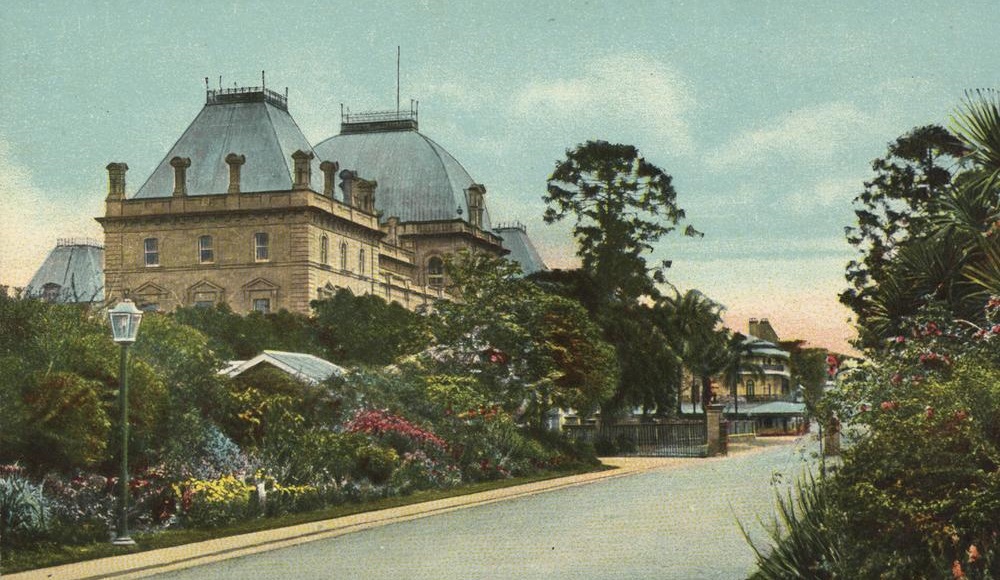
Parliament House is the seat of the Queensland State Parliament, which consists of the Legislative Assembly. The need for a parliament building arose after the state of Queensland was separated from New South Wales in 1859. Initially, the new parliament met in a barracks in Queen Street, but this was a temporary solution.
The Queensland government was in the process of building Government House, and therefore it was decided to wait with a parliament building until after the completion of the ongoing construction. In 1863, they chose the location for the parliament, and after an architectural competition had no final winner, they chose a proposal from the colonial architect Charles Tiffin.
On 14 July 1865 the foundation stone of the building was laid by Sir George Bowen. The first part was completed in 1867 and contained, among other things, stained glass windows imported from Birmingham. In 1868 the facade facing George Street was completed in mainly French Renaissance. Archways and colonnades facing George Street were added in 1878, and the wing facing Alice Street was completed in 1889.
You can still see the large parliament building in its beautiful surroundings, which over time also consists of modern Brisbane, and thus the parliament stands as a historical contrast to this. Parliament is open to visitors, so you have the opportunity to see the interior.
The Treasury Building is a building that was formerly the Government Building of the State of Queensland. It is a beautiful Italian Neo-Renaissance building, which was built in three stages in the period 1886-1928. The building initially stood as one of the symbols of self-governing Queensland.
The location on the corner of Queen Street and George Street was already reserved for public administration in 1825. Initially, a barracks was located here, and when the military left the site in 1864, a public office moved in, and ten years later a low and temporary building became listed.
In 1883 it was decided to build anew and colonial architect John James Clark designed the building so that it could be expanded in text with the need for more space. The first stage was built 1886-1889 and was used by the Queensland administration with the Prime Minister’s office, ministries etc. It was also from the balcony here that the Federation of Australia was proclaimed in Queensland in 1901.
Since then, the building was expanded again, and it was completed in 1928, although the construction of an annex later became necessary. And later, the remaining public institutions moved from the beautiful building to new constructions. Today, the Treasury Building is set up as a casino.
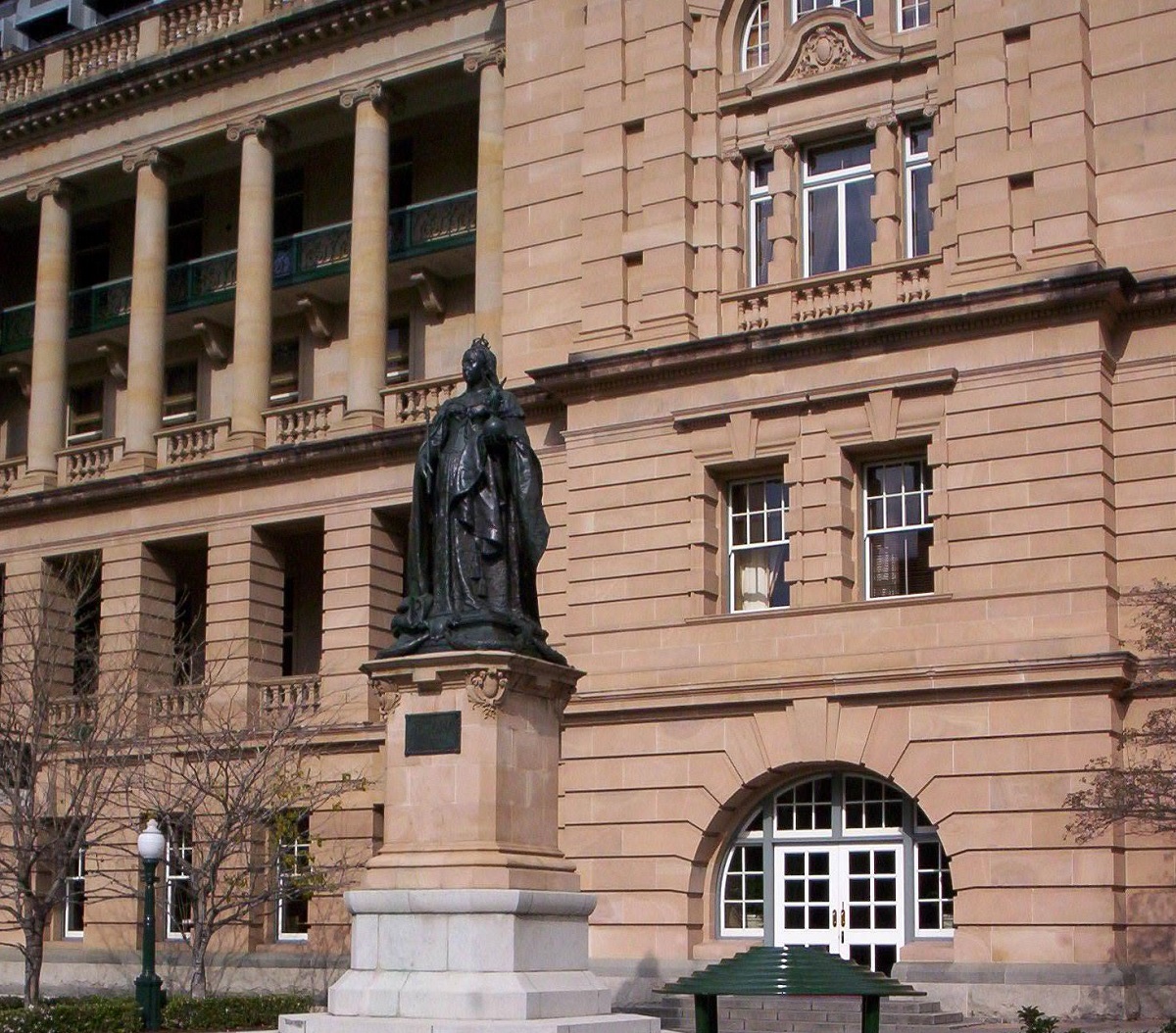
The Land Administration Building is one of Brisbane’s major buildings from around the year 1900. The building was built from 1899-1905 to house various Queensland government agencies including the State Premier and the building was also known as the Executive Building.
The large building was erected to house the Lands and Survey Departments, from which it derives its name; however, several other institutions moved in here in what stands as the most prominent example in Brisbane of Queensland government building activity associated with the economic boom of the late 1890s.
The Land Administration Building faces the green area, Queens Garden, where the building forms a beautiful setting together with the Treasury Building and the Old State Library. Today, the Treasury Building is set up as a casino, and the Land Administration Building functions as a hotel in connection with the casino.
Old Government House was built 1860-1862 as the residence of Sir George Bowen and family. Bowen was the first governor of the state of Queensland, and he took office after Queensland had been separated from New South Wales as a new colony in 1859. Old Government House was the first major construction undertaken by the new colonial government.
It was the colonial architect Charles Tiffin who designed the governor’s residence, which was beautifully located overlooking the Brisbane River. The house housed both private and public rooms and halls. The governors moved residence from 1910, when the government acquired a new and more modern governor’s residence. The buildings from the 1860s were then fitted out as an administration building for the University of Queensland.
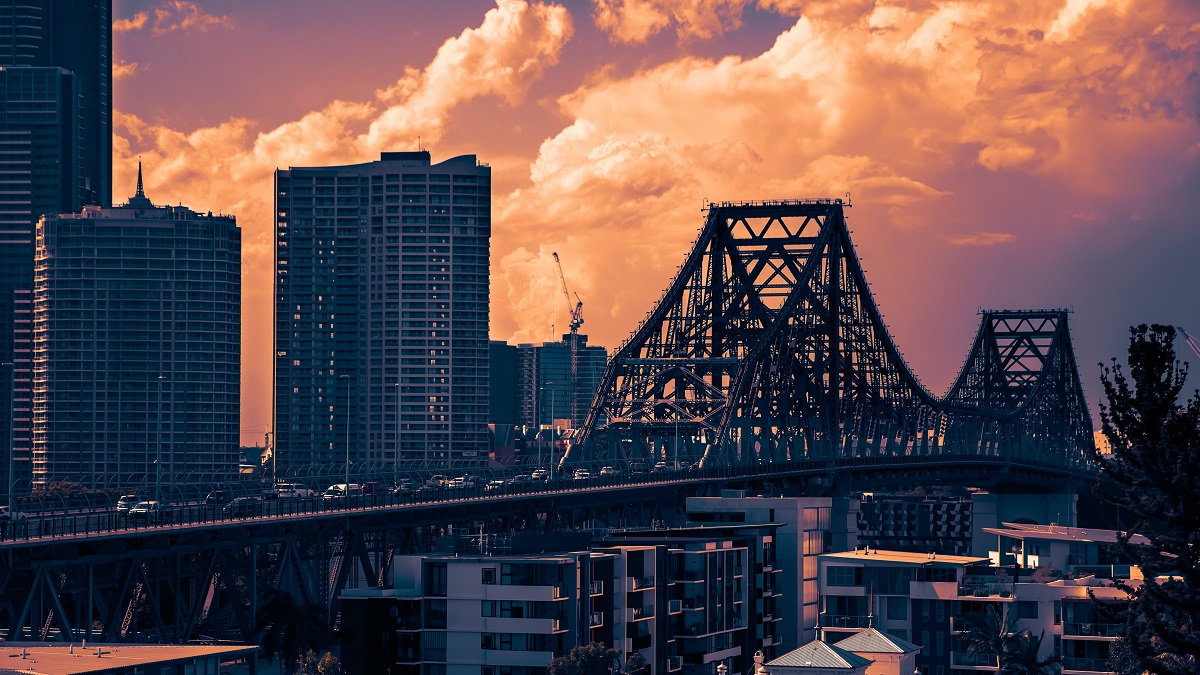
The Story Bridge is a beautiful bridge that opened in 1940 over the Brisbane River as Australia’s longest cantilever bridge. It has a length of 777 meters and connects suburbs to the north and south of the city. The bridge is named after John Douglas Story, who was a civil servant in Queensland and who was one of the major proponents of the construction.
Plans were established for several new bridges over the Brisbane River in the 1920s to divert traffic away from the central Victoria Bridge. The Queensland government hired engineer John Bradfield to design and build the bridge. John Bradfield designed it with inspiration from the Pont Jacques-Cartier in Canada, and Bradfield later designed the Sydney Harbor Bridge.
Government House is the official residence of the Governor of Queensland, who is the Australian monarch’s representative in the state. The house was built as a residence for Johann Christian Heussler in 1865, and it has housed governors since 1910, when the house replaced the current Old Government House.
Heussler was from Germany and moved to Victoria in 1852 and on to Brisbane in 1854. He engaged local architect Benjamin Backhouse to build his new residence, which he named Fernberg. The house stands beautifully and is furnished with, among other things, a finely decorated reception hall. On special occasions, the beautiful house is open to the public.
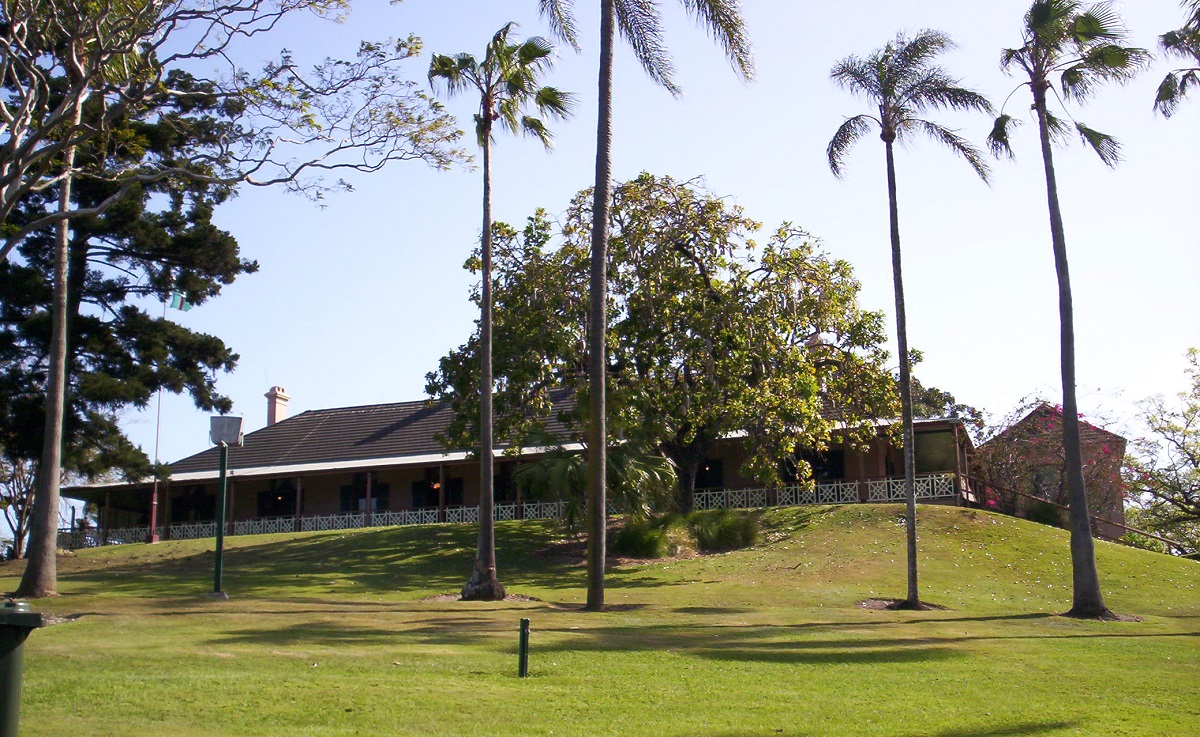
Newstead House is the name of Brisbane’s oldest surviving residential building. It was built in 1846 as the residence of Patrick and Catherine Leslie. The house was built as a smaller house in the colonial-Georgian style. It was later extended and is today painted and decorated in late Victorian style.
Newstead House was purchased by Brisbane City Council in 1918 and became service accommodation. In 1934 the Historical Society of Queensland leased part of the residence and later the building was used by American troops during the Second World War. Today there is a museum on the site, and events such as concerts are also organized in the house’s garden.
South Brisbane Town Hall is the old town hall of South Brisbane, which was established as an independent city in 1888. The town hall was opened in 1892 and was the town hall until 1925, when South Brisbane became part of Brisbane. Today, the old town hall is used for teaching.
A competition was called for the design of the new town hall in 1890. John Smith Murdoch’s proposal was chosen. The basic architectural style of the town hall building is Italian Neoclassicism, and the town hall consists of two main floors and a bell tower.
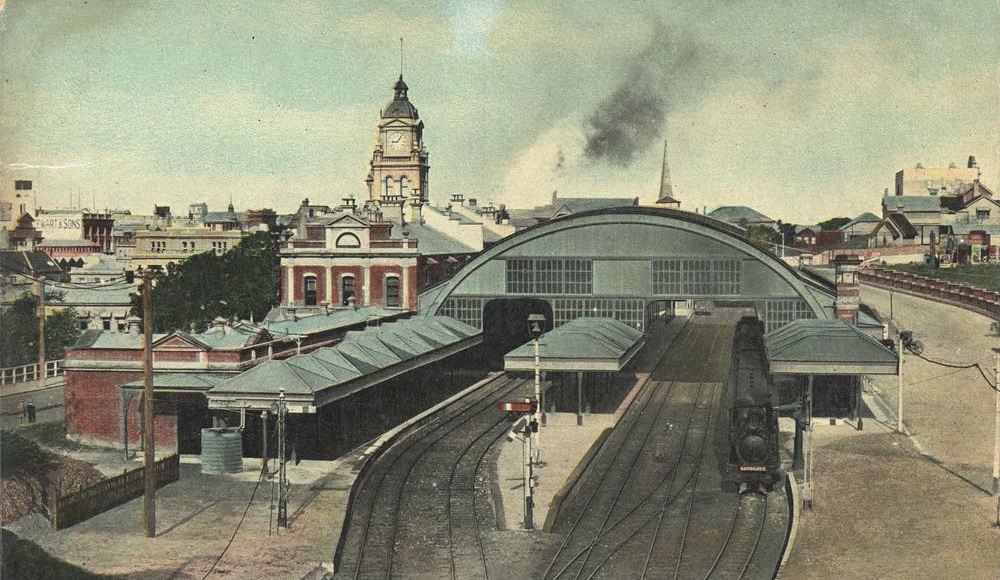
Central Railway Station is Brisbane’s beautiful and quite cozy main station. The first station opened here in 1889 as a terminus in Brisbane, where an existing line was extended here from Roma Street Station. Two years later, a tunnel was built from the station to the then Brunswick Street Station, and with that you could also drive to the city’s northern suburbs.
In 1899 a new railway station building was built with the main entrance from Ann Street. Since then, both the railway station and the city’s railway network have been significantly expanded. This has happened, among other things, with the construction of office buildings, shops and other things around the old railway station.
Brisbane Arcade is a particularly beautiful shopping arcade that was built in the years 1923-1924. The arcade connects the streets Adelaide Street and Queen Street, and there are fine shops facing both streets and on two floors in the arcade itself.
Brisbane Arcade was designed by Richard Gailey Junior, and it is the city’s first shopping arcade of this type, which was built in several European cities from the 1800s, among others. The arcade was one of several major building projects in the 1920s along Queen Street, where Tattersalls Club and the Regent Theater were also built.

ANZAC Square is a central square named after the Australian and New Zealand troops who fought in the world wars of the 20th century. The letters stand for Australian and New Zealand Army Corps, and in the square you can see an ANZAC memorial, the Shrine of Remembrance, with the eternal flame.
The Shrine of Remembrance was erected with great symbolism. The 18 pillars represent 1918, which was the year of peace after the First World War. There are bottle trees commemorating the Queensland Light Horse Regiments who served in South Africa’s Boer War, and Middle Eastern date palms symbolizing the success of Australian troops in the Middle East during both world wars. The three paths from the bottom of the stairs represent the three services; the army, navy and air force.
In continuation of ANZAC Square to the southeast you can see the Post Office Square park with the city’s fine post office from 1872. At the opposite end to the northwest of ANZAC Square is the Central Railway Station, which is Brisbane’s main railway station.
St. Andrew Uniting Church is a church that was completed in 1905 as the parish church for the neighborhood’s Presbyterian congregation. It is today one of Australia’s best examples of Romanesque-Byzantine inspired church construction.
It was the Australian architect George David Payne who designed the church. Throughout large parts of the Victorian era, British churches often drew inspiration from the Gothic, but from the end of the 19th century, more attention was paid to the Byzantine and Romanesque periods.
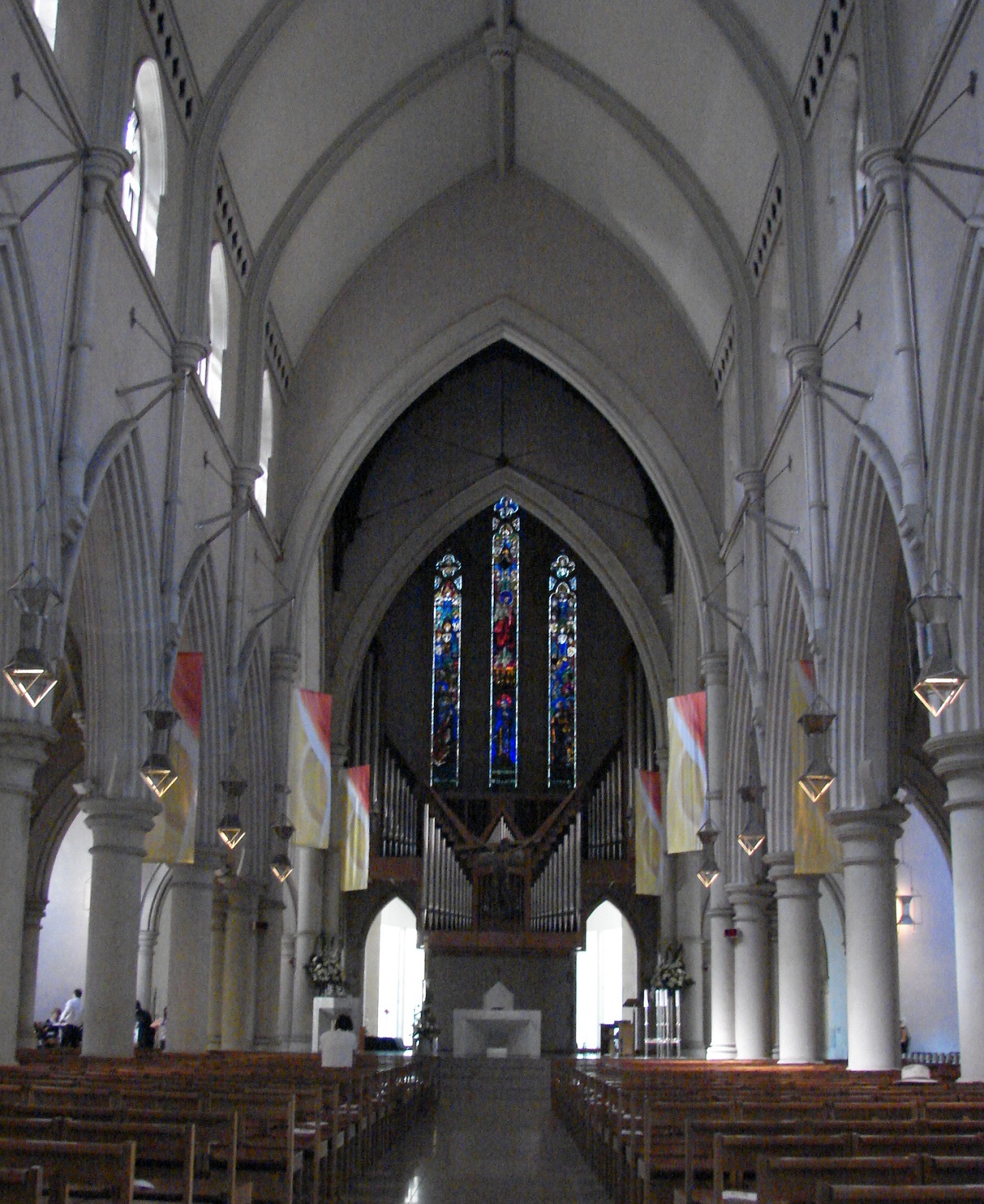
Cathedral of St. Stephen’s is Brisbane’s Catholic cathedral and thus the seat of the city’s Catholic Archbishop. The foundation stone for the cathedral was laid in 1863, but it took several decades of gradual expansion before today’s church was completed. Today, the church sits beautifully between modern high-rise buildings.
The Cathedral of St Stephen was consecrated in 1874 and in fact the church was only meant to be a temporary cathedral, but the intended Holy Name Cathedral was never built. The foundation stone was laid in 1928, but construction did not start. Today, you can only see a wall along Ann Street from the project.
Construction of the Cathedral of St Stephen began after the arrival of James Quinn from Ireland in 1861. He was Brisbane’s first Catholic bishop and he wanted to build a cathedral for the growing congregation. The church was built in neo-Gothic style, and in the church room you can see, among other things, some fine glass mosaics.
Queen Street Mall is Brisbane’s premier business precinct. A stroll here gives a good impression of the city’s modern buildings and daily life in Brisbane. There is of course also a good range of shops and restaurants.
Queen Street Mall is located between George Street and Edward Street. It was designed by Robin Gibson and opened by Queen Elizabeth II in 1982 as an initiative to attract more people to the city centre.
You can of course visit shops, department stores and shopping centers along Queen Street Mall. Along the way, you can also look for buildings worth seeing, such as the Brisbane Arcade from 1923-1924 and the Regent Theatre, which was built in 1928-1929.
All Saints Anglican Church is an 1869 church that stands as one of Brisbane’s most evocative places. Between the modern high-rise buildings in the city center stands the small church building with a simple and beautiful exterior and corresponding interior.
The church was founded in 1861, when the first building was erected from. The present church building was designed by Benjamin Blackhouse and completed in 1869. The fine building is Brisbane’s oldest Anglican church and it has a cozy church room.
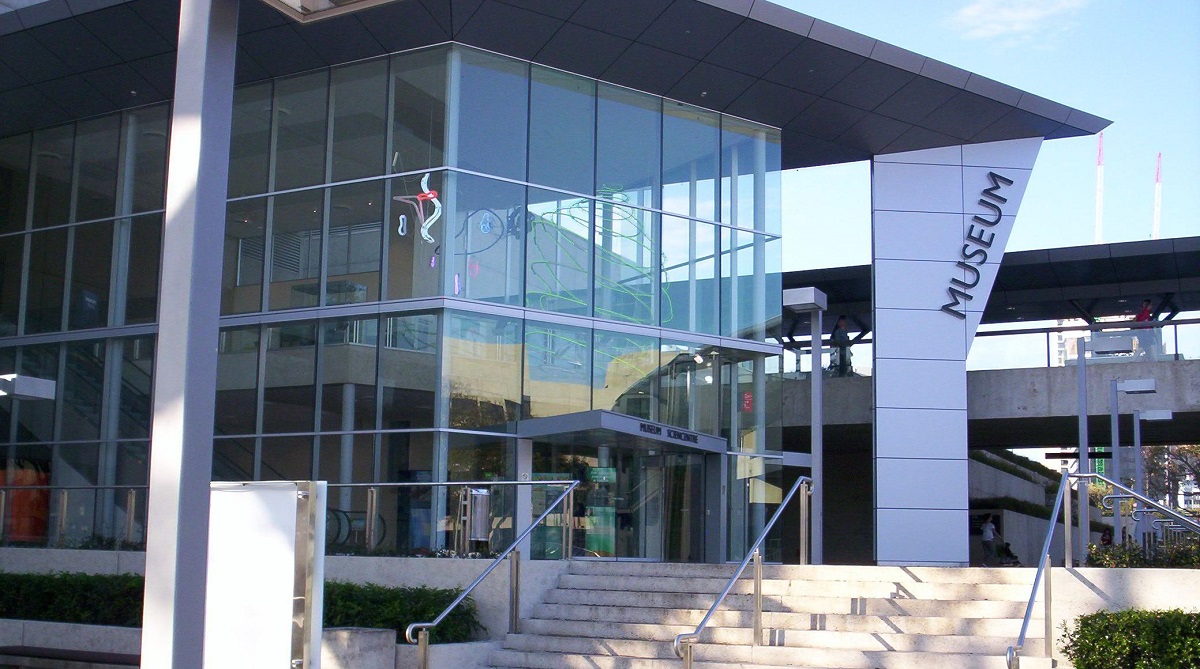
The Queensland Cultural Center is a collection of cultural institutions that can be visited in the South Bank neighbourhood. The center consists of the art museums Queensland Art Gallery and Queensland Gallery of Modern Art, the library State Library of Queensland, the museum Queensland Museum and the theater and concert hall Queensland Performing Arts Centre.
The area was established and built from 1976 and the original parts were designed by local architects Robin Gibson and Partners. The Queensland Cultural Center opened continuously throughout the 1980s and is beautifully situated along the Brisbane River with fine views of the city’s modern center on the opposite side of the river.
City Botanic Gardens is the name of Brisbane’s botanic gardens. Located along the winding course of the Brisbane River in the city’s modern business district, it forms a true oasis. It was laid out in 1865, and there are many old plants in addition to a multitude of flowers.
However, the area’s colonial history goes back further than 1865. In 1825, Moreton Bay Penal Settlement was established as a residence and settlement for convicts. The settlement was active from 1825 to 1842 and it became Brisbane. In 1825, this particular place was zoned for agriculture.
Much of the current botanic garden was selected as the site of a future public garden in 1828 by colonial botanist Charles Fraser, and the garden was later designated as a natural area before the garden was established. One of the curiosities is that Australia’s first jacaranda tree was planted here in 1864.
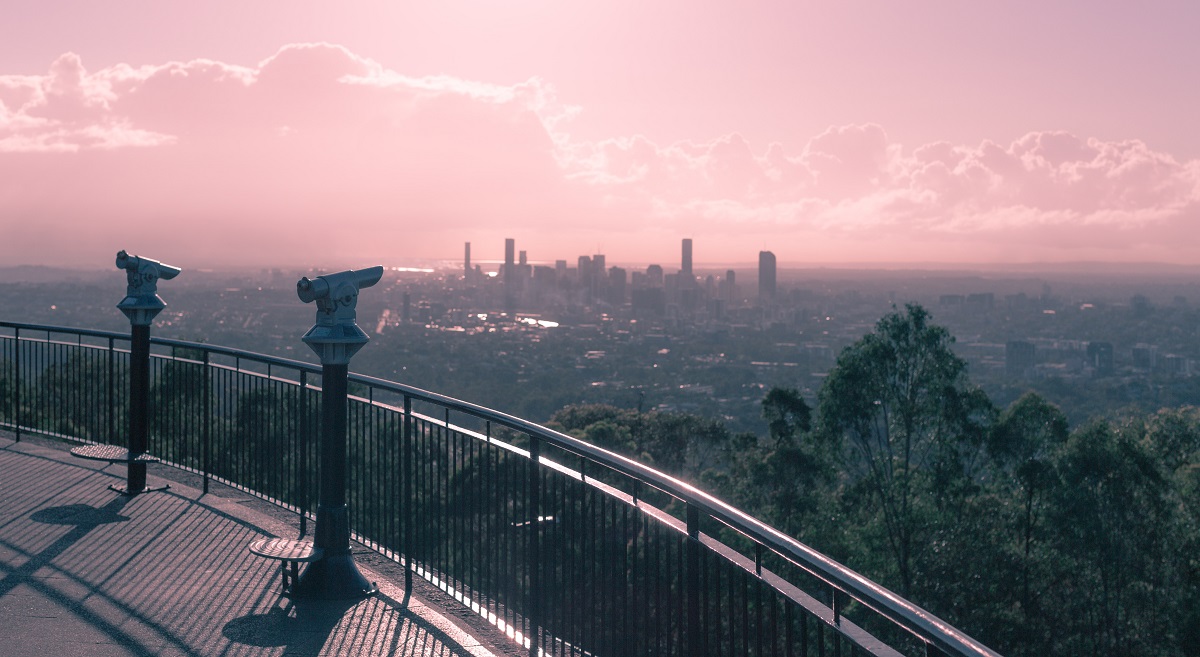
Mount Coot-tha Lookout is a lookout located on the heights of Mount Coot-tha a few kilometers west of the center of Brisbane. The top of the mountain reaches a height of 287 meters above sea level, and the large and easily accessible viewing platform is at a height of 226 meters.
Over many years, the mountain has attracted visitors, and the Mount Coot-tha Kiosk has been and is a popular and cozy place to eat at the viewpoint. From the platform at the site there is a fantastic view of Brisbane and the city’s surroundings, and you can see, among other things, Moreton Bay and the Glasshouse Mountains.
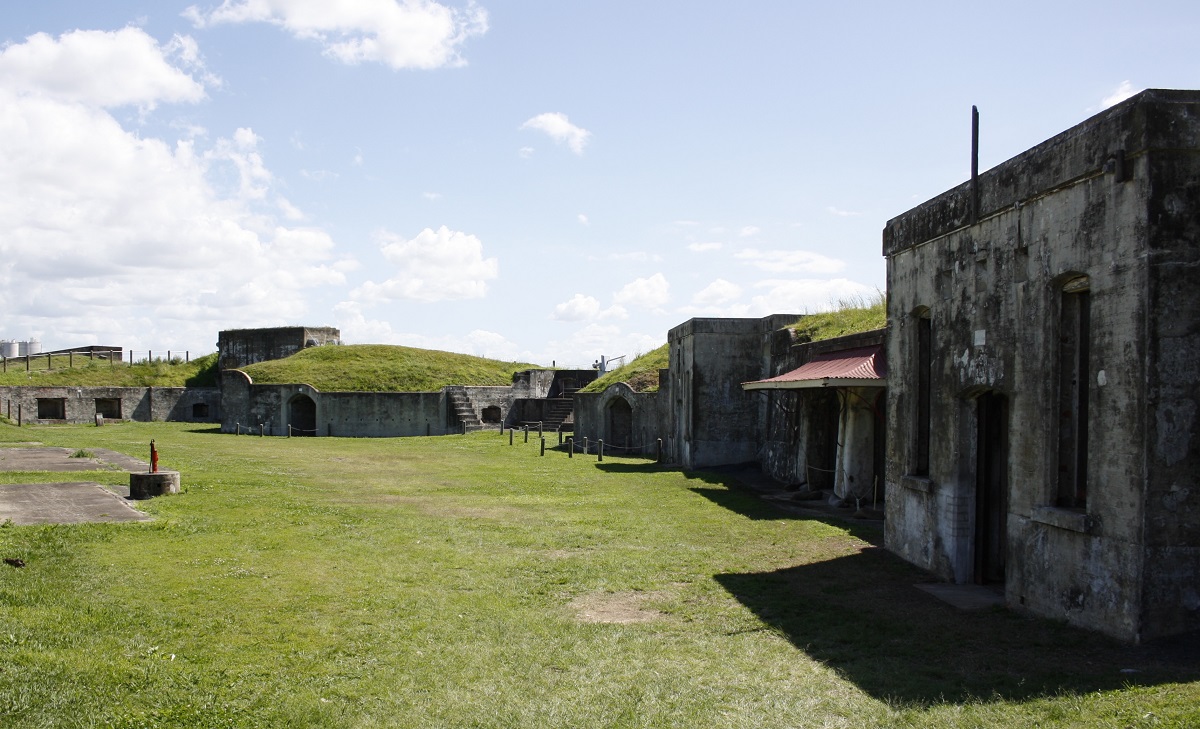
Fort Lytton is a fort that was built along the Brisbane River in the years 1880-1881 for the defense of the city. The fort is located east of the city and close to the mouth of the Brisbane River in Moreton Bay. In that way, the approach to Brisbane was strategically good.
The fort was used until the end of World War II and for certain purposes up to the 1960s. Today it is part of Fort Lytton National Park, a historic national park surrounding the colonial coastal fort and its history.
The National Park is a wonderful place for a nice walk, and in the fort and park you can visit the Fort Lytton Military Museum, which depicts the fort’s and Queensland’s military history. Several buildings, cannon pits and many effects are included in the museum.
St Helena Island National Park is an island located in Moreton Bay off Brisbane and the mouth of the Brisbane River. The island provided land for the state of Queensland’s first convict colony, and there are preserved ruins of some of the 19th century buildings.
The original Aboriginal name for the island is Noogoon, but it was renamed St Helena after an Aboriginal named Napoleon, who was exiled here in 1827. In the 19th century, the island also served as a quarantine station in addition to being a prison island.
Today, the island is designated as a national park in Queensland, and St Helena Island functions with its location and nature as a favorite for many birds. You can sail to the island on organized tours or go to St Helena Island yourself, where there are preserved parts of the 19th century facility.
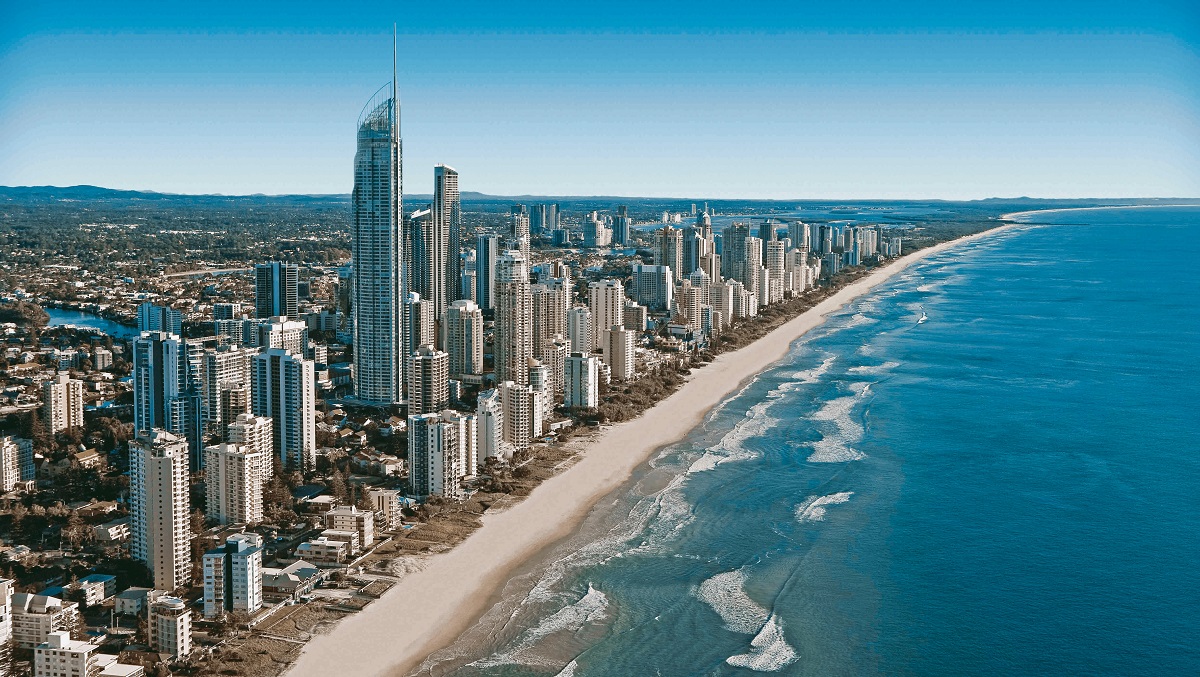
Gold Coast is a city on the Australian east coast in the southeast corner of Queensland. The Gold Coast is one of Australia’s largest cities, and it is the largest that is not the capital of one of the country’s states. Only Sydney, Melbourne, Brisbane, Perth and Adelaide are larger than the Gold Coast.
The city has gone through a colossal development as a holiday town with lovely beaches, hotels, theme parks and lots of other entertainment. It was the good location that started the growth of the Gold Coast. The first high-rise building was built in 1960, and the development of construction along the coast really took off in the 1980s.
There are many things to try in the Gold Coast area if you want to visit theme parks. For example, you can go to Dreamworld, Sea World, Wet’n’Wild Water World and Warner Bros. Movie World. You can also go up to the 77th floor of the 322 meter high skyscraper Q1, from where there is a panoramic view of the city.
There are of course also a number of beaches to choose from in the subtropical seaside resort. The suburb of Surfers Paradise is popular with many visitors who also want to surf. You can also choose Miami Beach or Burleigh Beach, where you can also see the area from above from Tumgun Lookout in Burleigh Head National Park.
159 Osborne Road
brookside.com.au
Redland Bay Road/Mt Cotton Road
capalabapark.com.au
1151 Creek Road
westfield.com/carindale
Gympie Road/Hamilton Road
westfield.com/chermside
Garden City
westfield.com/gardencity
Musgrave Road/Station Road
indooroopillyshopping.com.au
91 Queen Street
myercentreshopping.com.au
101 North Lakes Drive
westfield.com/northlakes
295 Gympie Road
westfield.com/strathpine
Sherwood Road
toowongvillage.com.au
Queen Street Mall
wgarden.com.au
Queen Street Mall, Ann Street, Chinatown, Little Stanley Street, MacArthur Central
Alma Park Zoo
Alma Road, Dakabin
almaparkzoo.com.au
Brisbane Tramway Museum
50 Tramway Street
brisbanetramwaymuseum.org
Dream World
Pacific Motorway, Coomera
dreamworld.com.au
Queensland Police Museum
200 Roma Street
police.qld.gov.au
Paradise Country Aussie Farm Tour
Entertainment Road, Oxenford
paradisecountry.com.au
Sea World
Sea World Drive, Surfers Paradise
seaworld.com.au
Warner Bros Movie World
Pacific Motorway, Oxenford
movieworld.com.au
Wet ‘n’ Wild Water World
Pacific Motorway, Oxenford
wetnwild.com.au
WhiteWater World
Pacific Motorway, Coomera
whitewaterworld.com.au
The city of Brisbane is named after Sir Thomas Brisbane who was governor of New South Wales 1821-1825. When the European settlement was established in 1824, it was a prisoners’ colony at the governor’s decision. The original location was 28 kilometers/17 miles north of the current town center, at what is today Redcliffe, but as early as 1825 Brisbane was moved to a place where the business district is now, due to more stable water supply.
The following decades, the settlement was a prisoners’ colony without a planned urban development, but in 1842 free settlement was opened in Brisbane. Development started, residence houses were built, and population increased from 829 in 1846 to 6,000 in 1859. That same year, Brisbane was chosen as the capital of the state of Queensland.
In the latter half of the 19th century, most things from the penal colony’s status were erased with the construction of many large and stately buildings symbolizing Brisbane’s and Queensland’s strengthened economy and political status. When Australia was formed in 1901, Queensland was the fastest growing nation in population and development, and Brisbane was the locomotive for growth.
The 1930s poverty and depression, which hit Brisbane like many other, led to city stagnation, and there were many shelter neighborhoods where the poorest had to live.
During World War II, the city grew and the population reached 750,000. The growth was not least due to the thousands of American soldiers stationed in the city in connection with the establishment of one of General Douglas MacArthur’s military headquarters in Brisbane.
After World War II, the economy boomed in Brisbane, where new businesses and suburbs arose with great speed. In the 1980s, the city was almost redefined through hosting both the Commonwealth Games (1982) and the World Exhibition (1988), which led to a great deal of construction activity, modernization of infrastructure, among other things, and the establishment of a number of new cultural institutions.
The large holiday resort of the Gold Coast is located south of Brisbane, and the tourism industry has contributed to the positive development of the city in recent decades. Today, around 1.8 million people live in Brisbane’s urban area, making it Australia’s third largest city. The Gold Coast is characterized by modern hotels, apartments and lots of entertainment.

Overview of Brisbane
Brisbane and Gold Coast are Australia’s favorite resort cities. Here, there is almost a guarantee of good weather, bathing and all the entertainment you can imagine, for which not least the Gold Coast is so famous.
However, the city has much more than the beaches to offer. There are several art museums, and if you want to go back to the early development of the area, there are preserved buildings from the 19th century. If you suddenly want to go to the beach, it can also be fulfilled in the very center of the city where the inviting South Bank Parklands are located.
About the upcoming Brisbane travel guide
About the travel guide
The Brisbane travel guide gives you an overview of the sights and activities of the Australian city. Read about top sights and other sights, and get a tour guide with tour suggestions and detailed descriptions of all the city’s most important churches, monuments, mansions, museums, etc.
Brisbane is waiting for you, and at vamados.com you can also find cheap flights and great deals on hotels for your trip. You just select your travel dates and then you get flight and accommodation suggestions in and around the city.
Read more about Brisbane and Australia
Buy the travel guide
Click the “Add to Cart” button to purchase the travel guide. After that you will come to the payment, where you enter the purchase and payment information. Upon payment of the travel guide, you will immediately receive a receipt with a link to download your purchase. You can download the travel guide immediately or use the download link in the email later.
Use the travel guide
When you buy the travel guide to Brisbane you get the book online so you can have it on your phone, tablet or computer – and of course you can choose to print it. Use the maps and tour suggestions and you will have a good and content-rich journey.
City Hall • Customs House • Old Windmill • Gold Coast

Overview of Brisbane
Brisbane and Gold Coast are Australia’s favorite resort cities. Here, there is almost a guarantee of good weather, bathing and all the entertainment you can imagine, for which not least the Gold Coast is so famous.
However, the city has much more than the beaches to offer. There are several art museums, and if you want to go back to the early development of the area, there are preserved buildings from the 19th century. If you suddenly want to go to the beach, it can also be fulfilled in the very center of the city where the inviting South Bank Parklands are located.
About the upcoming Brisbane travel guide
About the travel guide
The Brisbane travel guide gives you an overview of the sights and activities of the Australian city. Read about top sights and other sights, and get a tour guide with tour suggestions and detailed descriptions of all the city’s most important churches, monuments, mansions, museums, etc.
Brisbane is waiting for you, and at vamados.com you can also find cheap flights and great deals on hotels for your trip. You just select your travel dates and then you get flight and accommodation suggestions in and around the city.
Read more about Brisbane and Australia
Buy the travel guide
Click the “Add to Cart” button to purchase the travel guide. After that you will come to the payment, where you enter the purchase and payment information. Upon payment of the travel guide, you will immediately receive a receipt with a link to download your purchase. You can download the travel guide immediately or use the download link in the email later.
Use the travel guide
When you buy the travel guide to Brisbane you get the book online so you can have it on your phone, tablet or computer – and of course you can choose to print it. Use the maps and tour suggestions and you will have a good and content-rich journey.

The Land Administration Building is one of Brisbane’s major buildings from around the year 1900. The building was built from 1899-1905 to house various Queensland government agencies including the State Premier and the building was also known as the Executive Building.
The large building was erected to house the Lands and Survey Departments, from which it derives its name; however, several other institutions moved in here in what stands as the most prominent example in Brisbane of Queensland government building activity associated with the economic boom of the late 1890s.
The Land Administration Building faces the green area, Queens Garden, where the building forms a beautiful setting together with the Treasury Building and the Old State Library. Today, the Treasury Building is set up as a casino, and the Land Administration Building functions as a hotel in connection with the casino.
Old Government House was built 1860-1862 as the residence of Sir George Bowen and family. Bowen was the first governor of the state of Queensland, and he took office after Queensland had been separated from New South Wales as a new colony in 1859. Old Government House was the first major construction undertaken by the new colonial government.
It was the colonial architect Charles Tiffin who designed the governor’s residence, which was beautifully located overlooking the Brisbane River. The house housed both private and public rooms and halls. The governors moved residence from 1910, when the government acquired a new and more modern governor’s residence. The buildings from the 1860s were then fitted out as an administration building for the University of Queensland.

The Story Bridge is a beautiful bridge that opened in 1940 over the Brisbane River as Australia’s longest cantilever bridge. It has a length of 777 meters and connects suburbs to the north and south of the city. The bridge is named after John Douglas Story, who was a civil servant in Queensland and who was one of the major proponents of the construction.
Plans were established for several new bridges over the Brisbane River in the 1920s to divert traffic away from the central Victoria Bridge. The Queensland government hired engineer John Bradfield to design and build the bridge. John Bradfield designed it with inspiration from the Pont Jacques-Cartier in Canada, and Bradfield later designed the Sydney Harbor Bridge.
Government House is the official residence of the Governor of Queensland, who is the Australian monarch’s representative in the state. The house was built as a residence for Johann Christian Heussler in 1865, and it has housed governors since 1910, when the house replaced the current Old Government House.
Heussler was from Germany and moved to Victoria in 1852 and on to Brisbane in 1854. He engaged local architect Benjamin Backhouse to build his new residence, which he named Fernberg. The house stands beautifully and is furnished with, among other things, a finely decorated reception hall. On special occasions, the beautiful house is open to the public.

Newstead House is the name of Brisbane’s oldest surviving residential building. It was built in 1846 as the residence of Patrick and Catherine Leslie. The house was built as a smaller house in the colonial-Georgian style. It was later extended and is today painted and decorated in late Victorian style.
Newstead House was purchased by Brisbane City Council in 1918 and became service accommodation. In 1934 the Historical Society of Queensland leased part of the residence and later the building was used by American troops during the Second World War. Today there is a museum on the site, and events such as concerts are also organized in the house’s garden.
South Brisbane Town Hall is the old town hall of South Brisbane, which was established as an independent city in 1888. The town hall was opened in 1892 and was the town hall until 1925, when South Brisbane became part of Brisbane. Today, the old town hall is used for teaching.
A competition was called for the design of the new town hall in 1890. John Smith Murdoch’s proposal was chosen. The basic architectural style of the town hall building is Italian Neoclassicism, and the town hall consists of two main floors and a bell tower.

Central Railway Station is Brisbane’s beautiful and quite cozy main station. The first station opened here in 1889 as a terminus in Brisbane, where an existing line was extended here from Roma Street Station. Two years later, a tunnel was built from the station to the then Brunswick Street Station, and with that you could also drive to the city’s northern suburbs.
In 1899 a new railway station building was built with the main entrance from Ann Street. Since then, both the railway station and the city’s railway network have been significantly expanded. This has happened, among other things, with the construction of office buildings, shops and other things around the old railway station.
Brisbane Arcade is a particularly beautiful shopping arcade that was built in the years 1923-1924. The arcade connects the streets Adelaide Street and Queen Street, and there are fine shops facing both streets and on two floors in the arcade itself.
Brisbane Arcade was designed by Richard Gailey Junior, and it is the city’s first shopping arcade of this type, which was built in several European cities from the 1800s, among others. The arcade was one of several major building projects in the 1920s along Queen Street, where Tattersalls Club and the Regent Theater were also built.

ANZAC Square is a central square named after the Australian and New Zealand troops who fought in the world wars of the 20th century. The letters stand for Australian and New Zealand Army Corps, and in the square you can see an ANZAC memorial, the Shrine of Remembrance, with the eternal flame.
The Shrine of Remembrance was erected with great symbolism. The 18 pillars represent 1918, which was the year of peace after the First World War. There are bottle trees commemorating the Queensland Light Horse Regiments who served in South Africa’s Boer War, and Middle Eastern date palms symbolizing the success of Australian troops in the Middle East during both world wars. The three paths from the bottom of the stairs represent the three services; the army, navy and air force.
In continuation of ANZAC Square to the southeast you can see the Post Office Square park with the city’s fine post office from 1872. At the opposite end to the northwest of ANZAC Square is the Central Railway Station, which is Brisbane’s main railway station.
St. Andrew Uniting Church is a church that was completed in 1905 as the parish church for the neighborhood’s Presbyterian congregation. It is today one of Australia’s best examples of Romanesque-Byzantine inspired church construction.
It was the Australian architect George David Payne who designed the church. Throughout large parts of the Victorian era, British churches often drew inspiration from the Gothic, but from the end of the 19th century, more attention was paid to the Byzantine and Romanesque periods.

Cathedral of St. Stephen’s is Brisbane’s Catholic cathedral and thus the seat of the city’s Catholic Archbishop. The foundation stone for the cathedral was laid in 1863, but it took several decades of gradual expansion before today’s church was completed. Today, the church sits beautifully between modern high-rise buildings.
The Cathedral of St Stephen was consecrated in 1874 and in fact the church was only meant to be a temporary cathedral, but the intended Holy Name Cathedral was never built. The foundation stone was laid in 1928, but construction did not start. Today, you can only see a wall along Ann Street from the project.
Construction of the Cathedral of St Stephen began after the arrival of James Quinn from Ireland in 1861. He was Brisbane’s first Catholic bishop and he wanted to build a cathedral for the growing congregation. The church was built in neo-Gothic style, and in the church room you can see, among other things, some fine glass mosaics.
Queen Street Mall is Brisbane’s premier business precinct. A stroll here gives a good impression of the city’s modern buildings and daily life in Brisbane. There is of course also a good range of shops and restaurants.
Queen Street Mall is located between George Street and Edward Street. It was designed by Robin Gibson and opened by Queen Elizabeth II in 1982 as an initiative to attract more people to the city centre.
You can of course visit shops, department stores and shopping centers along Queen Street Mall. Along the way, you can also look for buildings worth seeing, such as the Brisbane Arcade from 1923-1924 and the Regent Theatre, which was built in 1928-1929.
All Saints Anglican Church is an 1869 church that stands as one of Brisbane’s most evocative places. Between the modern high-rise buildings in the city center stands the small church building with a simple and beautiful exterior and corresponding interior.
The church was founded in 1861, when the first building was erected from. The present church building was designed by Benjamin Blackhouse and completed in 1869. The fine building is Brisbane’s oldest Anglican church and it has a cozy church room.

The Queensland Cultural Center is a collection of cultural institutions that can be visited in the South Bank neighbourhood. The center consists of the art museums Queensland Art Gallery and Queensland Gallery of Modern Art, the library State Library of Queensland, the museum Queensland Museum and the theater and concert hall Queensland Performing Arts Centre.
The area was established and built from 1976 and the original parts were designed by local architects Robin Gibson and Partners. The Queensland Cultural Center opened continuously throughout the 1980s and is beautifully situated along the Brisbane River with fine views of the city’s modern center on the opposite side of the river.
City Botanic Gardens is the name of Brisbane’s botanic gardens. Located along the winding course of the Brisbane River in the city’s modern business district, it forms a true oasis. It was laid out in 1865, and there are many old plants in addition to a multitude of flowers.
However, the area’s colonial history goes back further than 1865. In 1825, Moreton Bay Penal Settlement was established as a residence and settlement for convicts. The settlement was active from 1825 to 1842 and it became Brisbane. In 1825, this particular place was zoned for agriculture.
Much of the current botanic garden was selected as the site of a future public garden in 1828 by colonial botanist Charles Fraser, and the garden was later designated as a natural area before the garden was established. One of the curiosities is that Australia’s first jacaranda tree was planted here in 1864.
Similar to Brisbane Travel Guide